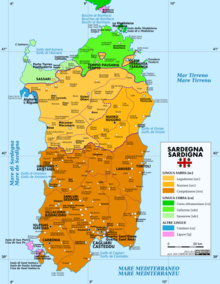
Corsican is a Romance language constituted by the complex of the Italo-Romance dialects spoken on the Mediterranean island of Corsica (France) and on the northern end of the island of Sardinia (Italy). Corsican is closely related to the Tuscan varieties from the Italian peninsula, and therefore to the Florentine-based standard Italian.

Logudorese Sardinian is one of the two written standards of the Sardinian language, which is often considered one of the most, if not the most conservative of all Romance languages. The orthography is based on the spoken dialects of central northern Sardinia, identified by certain attributes which are not found, or found to a lesser degree, among the Sardinian dialects centered on the other written form, Campidanese. Its ISO 639-3 code is src.
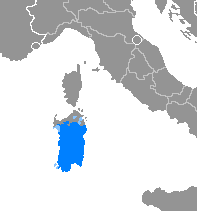
Sardinian or Sard is a Romance language spoken by the Sardinians on the Western Mediterranean island of Sardinia.

Sardinia is the second-largest island in the Mediterranean Sea, after Sicily, and one of the 20 regions of Italy. It is located west of the Italian Peninsula, north of Tunisia and immediately south of the French island of Corsica.

Gallura is a region in North-Eastern Sardinia, Italy.
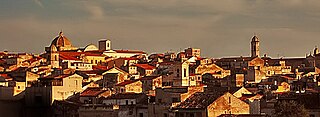
Sassari is an Italian city and the second-largest of Sardinia in terms of population with 127,525 inhabitants, and a Functional Urban Area of about 260,000 inhabitants. One of the oldest cities on the island, it contains a considerable collection of art.

Sassarese is an Italo-Dalmatian language and transitional variety between Sardinian and Corsican. It is regarded as a Corso–Sardinian language because of Sassari's historic ties with Tuscany and geographical proximity to Corsica. Despite the robust Sardinian influences, it still keeps its Corsican roots, which closely relate it to Gallurese; the latter is linguistically considered a Corsican dialect despite its geographical location, although this claim is a matter of controversy. It has several similarities to Italian and in particular the old Italian dialects from Tuscany.

Campidanese Sardinian is one of the two written standards of the Sardinian language, which is often considered one of the most, if not the most conservative of all the Romance languages. The orthography is based on the spoken dialects of central southern Sardinia, identified by certain attributes which are not found, or found to a lesser degree, among the Sardinian dialects centered on the other written form, Logudorese. Its ISO 639-3 code is sro.

The languages of Italy include Italian, which serves as the country's national language, as well as numerous local and regional languages, most of which, like Italian, belong to the broader Romance group. The majority of languages often labeled as regional are distributed in a continuum across the regions' administrative boundaries, with speakers from one locale within a single region being typically aware of the features distinguishing their own variety from one of the other places nearby.

The Corsicans are a Romance ethnic group. They are native to Corsica, a Mediterranean island and a territorial collectivity of France.

The Southern Romance languages are a primary branch of the Romance languages.

The Sardinians, or Sards, are a Romance language-speaking ethnic group native to Sardinia, from which the western Mediterranean island and autonomous region of Italy derives its name.
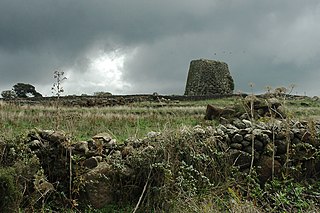
Paleo-Sardinian, also known as Proto-Sardinian or Nuragic, is an extinct language, or perhaps set of languages, spoken on the Mediterranean island of Sardinia by the ancient Sardinian population during the Nuragic era. Starting from the Roman conquest with the establishment of a specific province, a process of language shift took place, wherein Latin came slowly to be the only language spoken by the islanders. Paleo-Sardinian is thought to have left traces in the island's onomastics as well as toponyms, which appear to preserve grammatical suffixes, and a number of words in the modern Sardinian language.
Sardinian Literary Spring is a definition of the whole body of the literature produced in Sardinia from around the 1980s onwards.
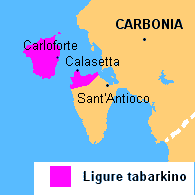
Tabarchino is a dialect of the Ligurian language spoken in Sardinia.
Sardinian dialects may refer to any of the following linguistic varieties of the Sardinian language, broadly divided into two subgroups:
The gosos or goccius are a kind of devotional and paraliturgical songs of Iberian origin typical of Sardinia, and written in the Sardinian language.
Limba Sarda Comuna (LSC) is an orthography for the Sardinian language, created with the aim of transcribing the many variants of spoken Sardinian, with their distinctive characteristics, in the same way, and adopted experimentally in 2006 by the Autonomous Region of Sardinia for the official writing of its acts, jointly with Italian.
The conjugation of Sardinian verbs are mainly divided according to infinitives into -are, -ere, and -ire verbs in north-central dialects for regular verbs, similar to the tripartite systems of Portuguese, Spanish, and Italian. In southern dialects, these infinitives above change to -ai, -i, and -iri, respectively. Irregular verbs also exist as well. Many Sardinian conjugated forms were similar and conservative phonologically to Classical Latin, although the number of tenses were greatly reduced and the remaining tenses rely on periphrasis.
Sardinian surnames are surnames with origins from the Sardinian language or a long, identifiable tradition on the Western Mediterranean island of Sardinia.
